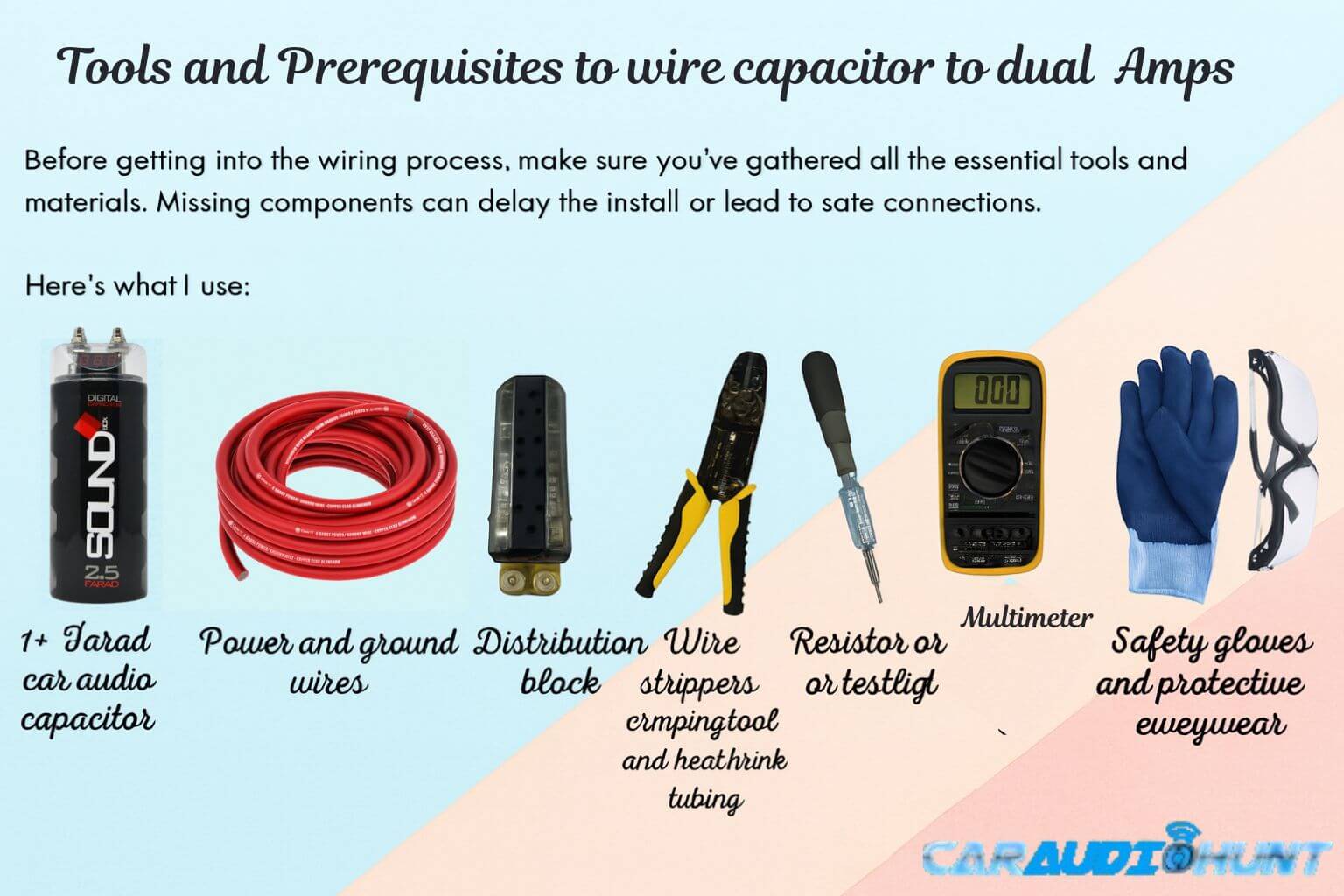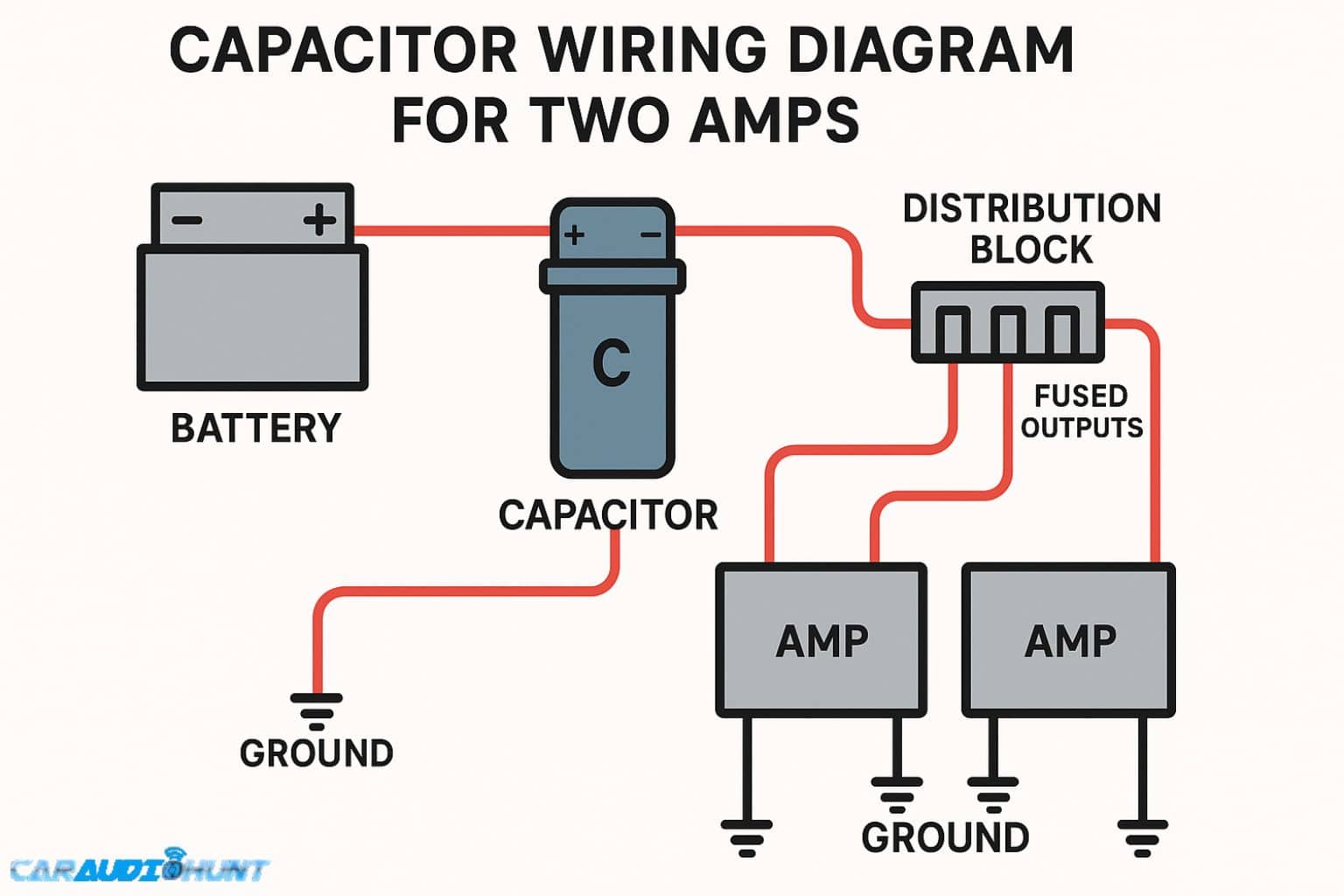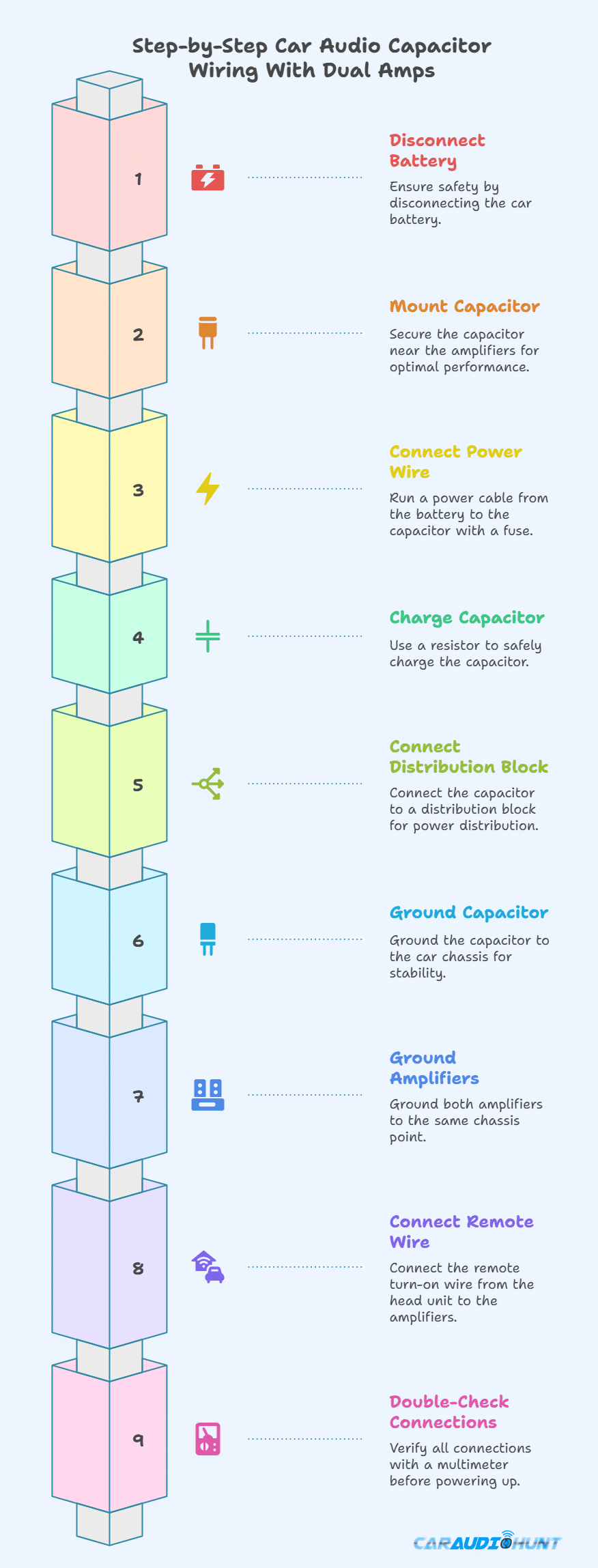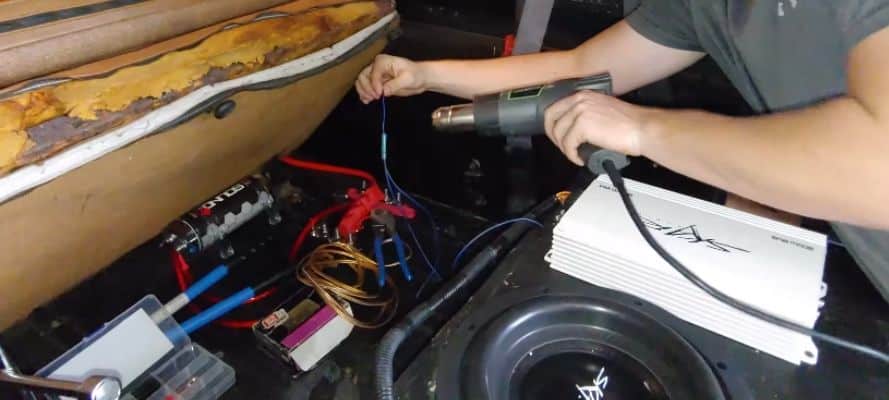After years working with custom and competition-level car audio systems, I’ve found that a well-planned capacitor setup can make all the difference between stable voltage and unpredictable performance.
In this guide, I’ll walk you through exactly how to wire a car audio capacitor with dual amps. It’s the method I use to ensure clean power delivery, deep bass response, and long-term component protection.
If you’re just starting out, I recommend checking out our beginner’s guide to capacitor installation before diving into this dual-amp setup.
In This Article
- Understanding the Basics Before Wiring
- Tools and Prerequisites
- Planning the Wiring Configuration
- Step-by-Step Car Audio Capacitor Wiring With Dual Amps
- Step 1: Disconnect the Battery
- Step 2: Mount the Capacitor
- Step 3: Connect the Power Wire to the Capacitor
- Step 4: Charge the Capacitor
- Step 5: Connect the Distribution Block
- Step 6: Ground the Capacitor
- Step 7: Ground the Amplifiers
- Step 8: Connect the Remote Turn-On Wire
- Step 9: Double-Check All Connections
- Mistakes to Avoid While Adding 2 Amps to 1 capacitor
- Pro-Level Wiring Tips I Recommend
- FAQs About Wiring a Capacitor with Dual Amps
- Wrapping Up
Understanding the Basics Before Wiring
Before starting the wiring process, it’s important to understand what a capacitor does and how it interacts with multiple amplifiers. Having a good grasp of the basics helps avoid common mistakes and power-related issues later on.
What a Capacitor Does in a Car Audio System
A capacitor in a car audio setup stores energy and releases it quickly when your system needs it especially during bass-heavy moments. This helps prevent voltage drops that can lead to dimmed headlights or sound distortion. It also takes pressure off your alternator by providing short bursts of power when the demand spikes. Overall, it helps keep your voltage more stable and your amplifier running efficiently.
If you're new to capacitors or want a deeper understanding, check out this guide on what a car audio capacitor does.
Can One Capacitor Serve Two Amps?
Yes, a single capacitor can be used with two amplifiers, as long as the total power draw stays within its limits. A good rule of thumb is to use 1 Farad of capacitance for every 1,000 watts RMS of combined amplifier power. So, if you’re running a 500-watt sub amp and a 400-watt 4-channel amp, a 1 Farad capacitor is actually enough. For higher-demand systems, I generally use a slightly larger capacitor that can help maintain stable voltage more consistently.
Types of Amplifier Setups
Knowing the type of amplifier you’re using is important when planning your wiring layout and capacitor placement.
- A mono amplifier powers a subwoofer and handles low-frequency signals only.
- A 2-channel amp can power a pair of speakers or be bridged for more output.
- A 4-channel amp is usually used to drive front and rear full-range speakers.
In a dual amp setup, one common configuration is using a mono amp for the subwoofer and a 4-channel amp for mids and highs. This setup covers the full audio range and helps deliver balanced sound throughout the vehicle.
Tools and Prerequisites
Before getting into the wiring process, make sure you’ve gathered all the essential tools and materials. Missing components can delay the install or lead to unsafe connections.

- 1+ Farad car audio capacitor
- Power and ground wires (4 AWG or 0 AWG recommended)
- Distribution block (fused or non-fused)
- Inline fuse holders and ring terminals
- Wire strippers, crimping tool, and heat shrink tubing
- Multimeter for voltage and continuity testing
- Resistor or test light for safely charging the capacitor
- Safety gloves and protective eyewear
If you’re not sure which capacitor to go with, check out my review guide on the best capacitors for car audio that suit different setups.
Planning the Wiring Configuration
Laying out your system properly is as important as the components themselves. A clean, well-planned wiring setup prevents voltage drops, unwanted noise, and potential safety issues. Here’s how to plan your capacitor and dual amp connection for reliable performance.

Capacitor Wiring Diagram for Two Amps
Series vs. Parallel (And Why It Matters)
- Always wire capacitors in parallel, not in series. That’s my preferred method for maintaining clean power flow.
- Parallel wiring ensures the capacitor shares the same power path as the amplifiers, allowing it to buffer voltage effectively.
Power Distribution to Multiple Amps
- A distribution block after the capacitor works well for splitting power to each amp, and it’s the setup I use in most builds.
- Install fuses near the battery and again close to each amplifier to protect your wiring and equipment. If you're unfamiliar with inline fuse holders and their role in system protection, check out this complete guide to fuse holders for a deeper understanding.
Grounding Best Practices
- A shared ground point is simple, but it may introduce noise in some setups.
- For best results, I use equal-length ground wires and connect them to a solid, paint-free chassis point to ensure stable grounding for both amplifiers.
Step-by-Step Car Audio Capacitor Wiring With Dual Amps
Now that everything’s ready, it’s time to wire the system. Follow each step carefully to ensure safe and reliable performance. This is the exact process I follow when wiring capacitors with dual amplifiers. It’s worked for me in dozens of builds.

Want to share this infographic?
Copy and paste the code below into your blog or website:
Step 1: Disconnect the Battery
Start by disconnecting the negative terminal of your car battery. This prevents accidental shorts and keeps you safe while working with live wires.
Step 2: Mount the Capacitor
Secure the capacitor close to your amplifiers, ideally within 18 inches. Keeping the distance short reduces resistance and allows the capacitor to respond quickly when your system demands power. That proximity makes a real difference in power transfer during bass peaks.
Step 3: Connect the Power Wire to the Capacitor
Run a 0 AWG power cable from the battery to the capacitor’s positive terminal. Be sure to install an inline fuse within 18 inches of the battery to protect the circuit. I recommend using high-quality fuse holders for a secure, weather-resistant connection.
Step 4: Charge the Capacitor
Before connecting it fully, charge the capacitor using a resistor or test light. Connect the resistor between the power cable and the positive terminal on the capacitor. Once the test light dims or turns off, the capacitor is charged and safe to use. See full capacitor charging tutorial Here →
Step 5: Connect the Distribution Block
After the cap is charged, connect a short wire from its output terminal to a distribution block. Then run two separate power wires from the block to your amplifiers. I always make sure the wire gauge remains consistent from the cap to the amps to avoid voltage drops.
Step 6: Ground the Capacitor
Use the same gauge wire as your power wire to ground the capacitor. Connect it to a clean, bare metal point on the chassis, ideally within 18 inches of the cap’s location.
Step 7: Ground the Amplifiers
Ground both amps using equal-gauge, equal-length wires. I recommend using the same chassis point as the capacitor to minimize ground loop interference, especially in high-powered systems.
Step 8: Connect the Remote Turn-On Wire
Run the remote turn-on lead from your head unit. If needed, split the wire using a Y-connector and send one lead to each amp. This wire ensures the amps turn on only when the head unit is powered. Must test this signal with a multimeter before finalizing.
Step 9: Double-Check All Connections
Before reconnecting the battery, go over all wiring. Use a multimeter to check for continuity and verify voltage at each point. Confirm that all fuses are installed and terminals are secure. Taking a few extra minutes here saves hours of troubleshooting later.
I always give one final pass with the multimeter. It’s a simple way to catch anything before powering up.
Mistakes to Avoid While Adding 2 Amps to 1 capacitor
I’ve seen many DIYers and even pros make avoidable mistakes that cause electrical problems or weaken system performance. These are the issues I always warn against during installs.
Avoid these common pitfalls to prevent power loss, noise interference, or equipment damage:
1. Using undersized power or ground wires - Leads to voltage drop, weak bass, and potential overheating.
2. Poor grounding - Can cause humming, whining, or ground loop issues.
3. Skipping fuse blocks - Increases the risk of shorts and electrical fire.
4. Mounting the capacitor too far from the amps - Reduces performance due to added resistance.
5. Failing to pre-charge the capacitor - May send a surge that damages your amp or head unit.
Pro-Level Wiring Tips I Recommend
These are some of the expert-level tips I personally follow and suggest to every serious car audio builder. They’re very useful when you're working with higher-powered dual amp systems.
- Upgrade alternator or add second battery for extreme systems.
- Use twisted power and signal wires to reduce interference.
- Label all connections.
- Keep wiring runs short for efficiency.
- Complete the Big 3 upgrade to reduce voltage drop and improve current flow.
FAQs About Wiring a Capacitor with Dual Amps
Here are some of the questions I get asked most often by clients and readers when it comes to capacitor and dual amp setups. Still have questions? These quick answers should clear up the most common doubts:
Can you run two amps off one capacitor?
Yes, as long as the capacitor is sized correctly and wired properly through a distribution block.
Is a capacitor better than a second battery?
Not exactly. A capacitor handles short power spikes, while a second battery provides long-term reserve power. They serve different purposes.
How do you size a capacitor for two amps?
Add up the total RMS wattage of both amps, then use at least 1 Farad per 1,000 watts. Slightly oversizing is often safer.
Where should I mount the capacitor in a dual amp setup?
As close as possible to the amps or distribution block. Short wiring distances improve performance and reduce voltage loss.
Can I charge the capacitor directly from the battery?
Not directly. You must use a resistor or test light during charging to avoid a dangerous current spike that could damage electronics or spark heavily.
What happens if I use a capacitor that’s too small?
An undersized capacitor may fail to supply enough power during bass peaks, leading to dimming lights, distortion, or strain on your amps.
Wrapping Up
From my experience, wiring a car audio capacitor with dual amplifiers doesn’t have to be complicated. Once you understand the basics and follow the right steps, you’ll enjoy smoother voltage flow, cleaner sound, and fewer system issues down the road.
The key is careful planning. Use proper wire gauges, maintain clean grounds, and always charge the capacitor before connecting it. Mount everything securely and keep wiring runs short to reduce resistance.
For higher-powered setups, consider upgrading your capacitor or pairing it with a second battery to maintain consistent voltage under load.
Read Related Guides:

